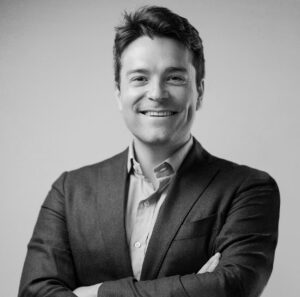Simons Foundation awards $8 million grant to uncover secrets of black holes and strong gravity
Article adapted from a press release written by the University of Illinois Urbana-Champaign
 Over the next four years, Assistant Professor of Physics and Astronomy Alex Lupsasca will lead a Vanderbilt team in a multidisciplinary, multi-institutional collaboration funded by an $8 million grant from the Simons Foundation with a focus on black holes and strong gravity.
Over the next four years, Assistant Professor of Physics and Astronomy Alex Lupsasca will lead a Vanderbilt team in a multidisciplinary, multi-institutional collaboration funded by an $8 million grant from the Simons Foundation with a focus on black holes and strong gravity.
The Simons Collaboration on Black Holes and Strong Gravity will support the work of Lupsasca and 11 other co-PIs at separate institutions to develop a robust theoretical framework for deciphering the secrets encoded in gravitational-wave data, including possible extensions to Albert Einstein’s theory of general relativity.
The strong gravity of black holes prevents everything, even light, from escaping the interior. Inside black holes, Einstein’s theory predicts that the curvature of spacetime diverges, forming singularities that signal the potential breakdown of spacetime itself and delineate the edge of our physical understanding.
The cataclysmic collision of black holes shakes the fabric of the universe, generating vibrations in spacetime that Einstein dubbed “gravitational waves.” These vibrations travel through the cosmos almost unimpeded, carrying secrets about our universe that we can now decode by listening. The data from these waves may be used to explain the matter-antimatter asymmetry of the universe, the nature of dark matter, and physics that potentially diverges from Einstein’s theory, including the fundamental incompatibilities of quantum mechanics and gravity.
“Black holes are the objects that produce the strongest gravitational fields in our universe, and physicists believe that they hold the clue to elucidating gravity—the most mysterious of forces,” Lupsasca said. “We are hoping to understand whether and how near-future black hole observations could force us to go beyond Einstein’s theory of general relativity. We know that the theory is incomplete, but we do not know how to revise it. A major goal of black hole physics is to discover the next deeper layer of fundamental theory, including what is inside a black hole and what is the ultimate nature of spacetime.”
Gravitational-wave observational capabilities are rapidly advancing thanks to gravitational-wave detectors such as LIGO, Virgo, and KAGRA, and experts predict that the volume of the universe we can access through gravitational-wave data will increase over the next few years, making the timing of this collaboration crucial.
To collect the data, the multi-institutional team of researchers will perform analytical calculations, run computer simulations, and then test both findings against observations. The major goal of the research collaboration is to grow deep insights on the interconnections between strong gravity in general relativity, strong gravity beyond Einstein, and gravitational observations. Each of these interconnected themes provides unique insights that, when combined, will allow researchers to develop accurate models, interpret gravitational observations, and make new discoveries.
“I am extremely grateful that private foundations are stepping up to support fundamental, curiosity-driven research,” Lupsasca said. “I think the questions that we investigate at the research frontier in physics and astronomy have wide appeal to all of us, and that as a society we should strive to keep pushing this frontier.”
Lupsasca has also been studying black holes as the project scientist for the Black Hole Explorer (BHEX), a mission to launch a satellite into Earth’s orbit that will take the highest resolution photos of black holes in the history of astronomy. Lupsasca won a 2024 New Horizons in Physics Prize for this research.
The Simons grant will provide postdoctoral and graduate student support, as well as travel between member institutions and various meetings per year. The collaboration will enlist the expertise of physicists, mathematicians, and data scientists whose research programs are already immersed in these astrophysical mysteries.
“We live in a special time in the history of physics, when we are suddenly able to measure properties of real black holes for the first time,” Lupsasca said. “As recently as 10 years ago, we had never directly observed a black hole, but now we interact with them routinely. The next decade will deliver a torrent of new black hole data, and this project will lay the theoretical foundation needed to understand and interpret black hole observations.”
Read more about the collaboration on the Simons Foundation’s website.
